How to Plant Perpetual Spinach in July: Your Complete UK Growing Guide
Discover why July is the perfect time to plant perpetual spinach in the UK. This comprehensive guide covers everything from soil preparation to harvesting, ensuring you'll enjoy fresh, nutritious greens well into winter and beyond.
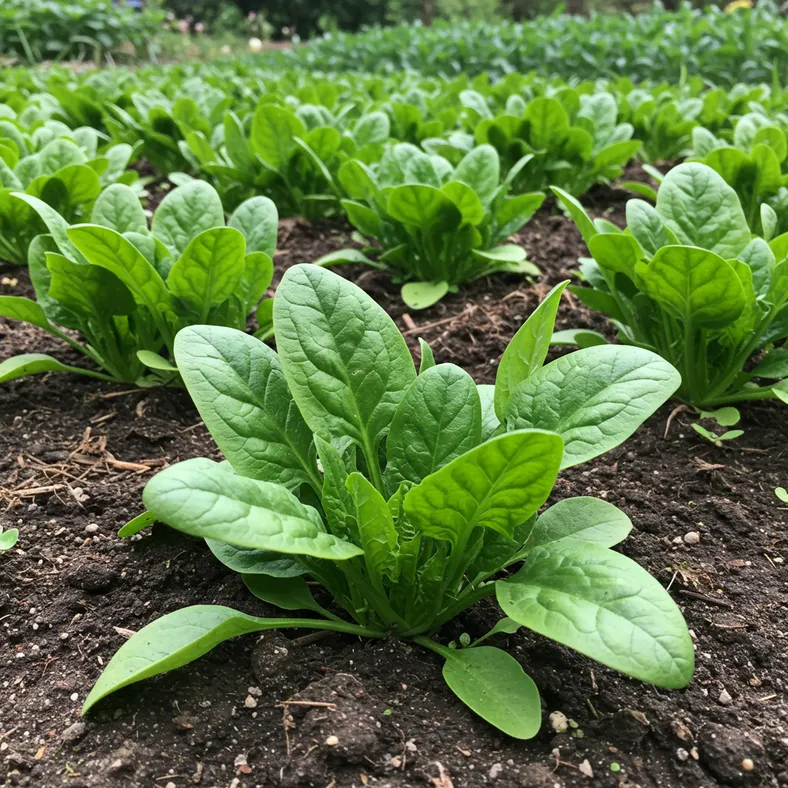
- Why July is Perfect for Planting Perpetual Spinach in the UK
- Soil Preparation and Site Selection
- Sowing Perpetual Spinach Seeds in July
- Watering and Early Care
- Harvesting Your July-Planted Perpetual Spinach
- Winter Care and Protection
- Common Problems and Solutions
- Companion Planting and Garden Integration
- Nutritional Benefits and Culinary Uses
July presents the perfect opportunity to plant perpetual spinach in the UK, setting yourself up for fresh, nutritious greens that will continue producing through autumn, winter, and well into next year. Unlike traditional spinach that bolts in hot weather, perpetual spinach (Beta vulgaris subsp. cicla var. cicla) thrives in July's warm conditions and won't run to seed, making it an ideal choice for UK gardeners seeking reliable harvests.
This hardy, cut-and-come-again crop offers all the flavour and nutrition of regular spinach but with none of the usual frustrations. Whether you're a beginner gardener or experienced grower, perpetual spinach planted in July will reward you with continuous harvests for up to 12 months, making it one of the most productive vegetables you can grow.
Why July is Perfect for Planting Perpetual Spinach in the UK
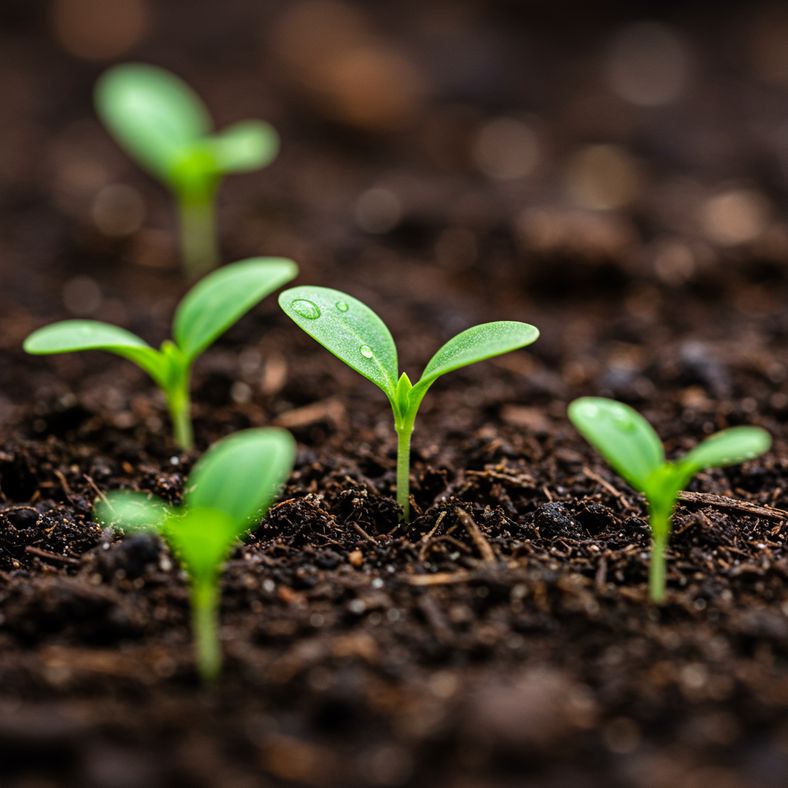
July offers ideal conditions for establishing perpetual spinach in UK gardens. The warm soil temperatures, typically ranging from 15-20°C, provide optimal germination conditions whilst still allowing plenty of growing time before winter sets in.
Unlike true spinach (Spinacia oleracea), perpetual spinach is actually a type of leaf beet or chard that doesn't bolt in hot weather. This makes July planting particularly successful because:
- Reliable germination: Seeds germinate consistently in 7-14 days when soil temperatures reach 16-18°C
- Extended growing season: Plants established in July have 12-16 weeks to develop strong root systems before winter
- No bolting issues: Unlike annual spinach, perpetual spinach thrives in warm July conditions
- Continuous harvests: July plantings provide fresh leaves from September through the following spring
The long daylight hours of July also promote vigorous leaf growth, whilst the established plants will easily survive UK winters with minimal protection. This timing ensures you'll have fresh greens when shop-bought alternatives are most expensive.
Soil Preparation and Site Selection
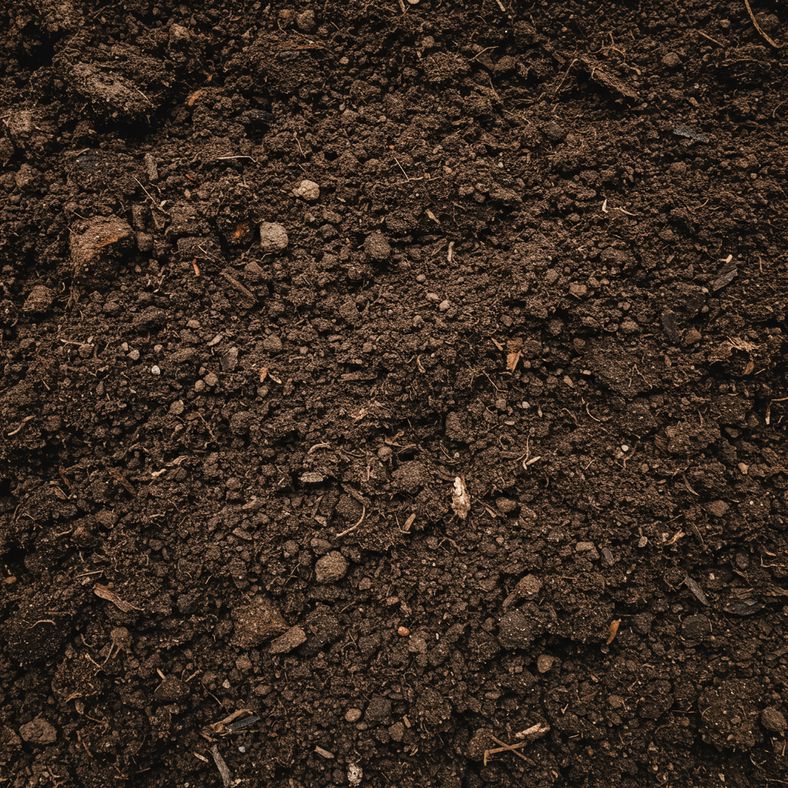
Success with perpetual spinach begins with proper soil preparation. This adaptable crop tolerates various soil types but thrives in well-prepared, fertile ground.
Soil Requirements
Perpetual spinach prefers:
- Well-drained soil: Avoid waterlogged conditions that can cause root rot
- pH level: Neutral to slightly alkaline (6.0-7.5) - avoid very acidic soils
- Rich organic content: High in organic matter for sustained nutrition
- Moisture retention: Holds water well but doesn't become waterlogged
Site Selection
Choose a location that receives:
- Full sun to partial shade: 6-8 hours of sunlight daily, though it benefits from afternoon shade in hot weather
- Good air circulation: Prevents fungal diseases whilst avoiding windy spots
- Easy access: For regular harvesting and maintenance
Soil Preparation Steps
Begin preparation 2-3 weeks before sowing:
- Clear the area: Remove weeds, stones, and debris
- Dig or fork: Work the soil to 20-25cm depth
- Add organic matter: Incorporate 2-3 inches of well-rotted compost or manure
- Rake level: Create a fine, even surface for sowing
- Water thoroughly: Ensure soil is moist but not waterlogged
If your soil is heavy clay, consider creating raised beds or adding coarse sand and organic matter to improve drainage. Poor soils can be enhanced with a balanced organic fertiliser raked in before sowing.
Sowing Perpetual Spinach Seeds in July
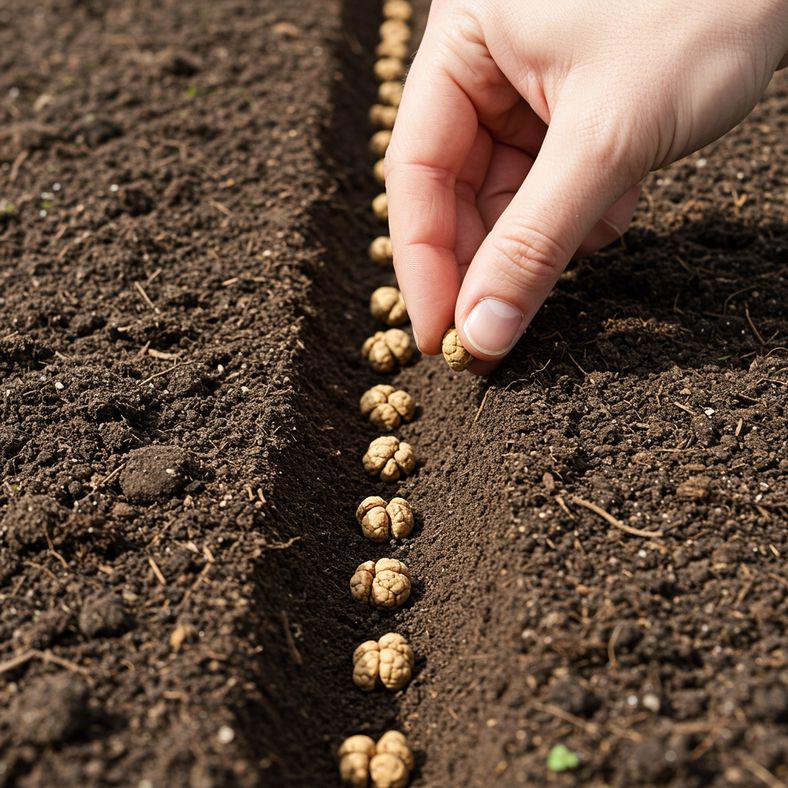
July sowing of perpetual spinach seeds is straightforward and highly successful when you follow proper techniques. The warm soil conditions ensure quick germination and strong establishment.
Seed Characteristics
Perpetual spinach seeds are distinctive:
- Large and corky: Each 'seed' is actually a cluster containing 3-5 individual seeds
- Irregular shape: Rough, wrinkled appearance that's perfectly normal
- Good viability: Fresh seeds typically show 70-80% germination rates
Direct Sowing Method
Follow these steps for successful July sowing:
- Create shallow drills: Make furrows 1.5-2cm deep using a hoe or finger
- Space rows correctly: Allow 30-40cm between rows for easy access
- Sow seeds: Place seeds 5-10cm apart along the drill
- Cover lightly: Backfill with soil and firm gently
- Water carefully: Use a fine rose to avoid washing away seeds
- Mark rows: Use labels to identify sowing areas
Alternative Sowing Methods
Station sowing: Sow 2-3 seeds every 20cm, thinning to the strongest seedling later. This reduces the need for extensive thinning.
Module sowing: Start seeds in 7-9cm modules filled with seed compost, sowing one seed per module. Transplant after 4-5 weeks when plants are 5-7cm tall.
Germination Expectations
In July's warm conditions, expect:
- Germination time: 7-14 days (up to 21 days in cooler periods)
- Temperature needs: Soil temperature of 16-18°C for best results
- Emergence rate: 70-80% with fresh seeds
Remember that germination may be slower if temperatures exceed 25°C, so consider sowing in a partially shaded area during particularly hot spells.
Disclaimer: This article contains Amazon affiliate links. We may earn a small commission from qualifying purchases at no additional cost to you.
For reliable germination and healthy growth, consider using Garden Spinach Beet Perpetual Fresh Vegetable Seeds, which provide excellent results when sown in July.
Watering and Early Care
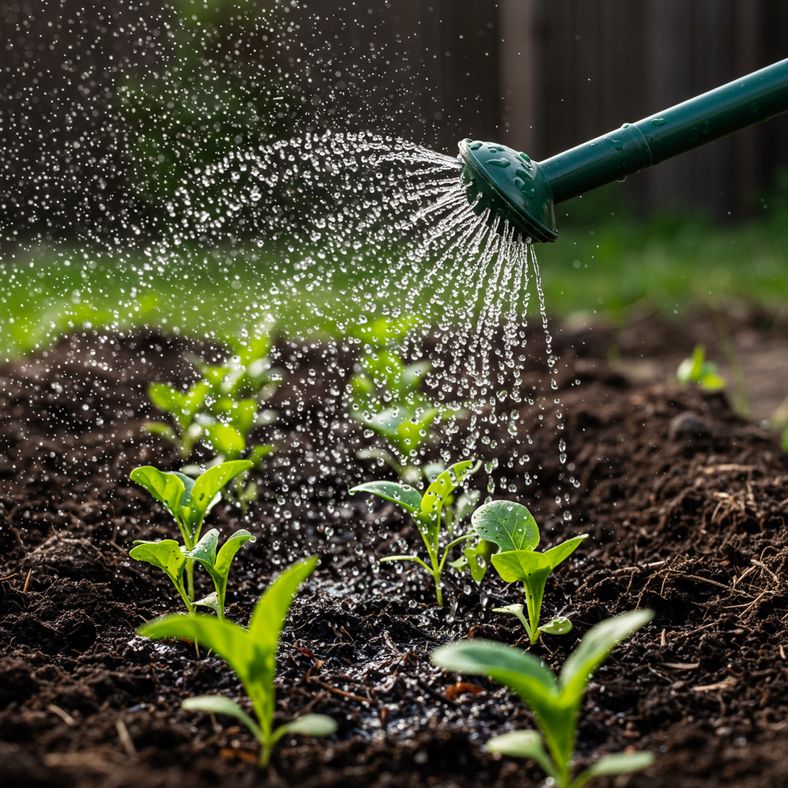
Proper watering and early care are crucial for establishing healthy perpetual spinach plants from July sowings. Consistent moisture and appropriate maintenance ensure strong growth and continuous harvests.
Watering Guidelines
Initial watering: Water gently immediately after sowing using a fine rose attachment to avoid displacing seeds. The soil should be moist but not waterlogged.
Germination period: Maintain consistent moisture during the 7-14 day germination period. Check daily and water lightly if the surface appears dry.
Established plants: Once seedlings emerge, water deeply but less frequently to encourage deep root development. Aim for 2-3cm of water per week.
Watering Best Practices
- Water at soil level: Avoid watering leaves to prevent fungal diseases
- Early morning watering: Reduces evaporation and allows plants to dry before evening
- Consistent moisture: Avoid alternating between dry and soggy conditions
- Mulching: Apply organic mulch around plants to retain moisture and suppress weeds
Thinning Seedlings
Begin thinning when seedlings reach 3-5cm tall:
- First thinning: Remove weaker seedlings from each cluster, leaving the strongest
- Second thinning: Thin to 15-20cm apart for full-sized plants
- Use thinnings: Young leaves make excellent additions to salads
- Careful technique: Pinch or cut rather than pull to avoid disturbing remaining plants
Protection and Support
Bird protection: Cover young plants with fine netting or fleece to prevent pigeon damage. Remove once plants are established (6-8 weeks).
Pest monitoring: Watch for aphids and leaf miners, particularly during warm weather. Remove affected leaves promptly.
Feeding Requirements
Perpetual spinach benefits from regular feeding:
- Liquid fertiliser: Apply nitrogen-rich liquid feed every 2-3 weeks
- Organic options: Use comfrey tea or diluted seaweed extract
- Avoid over-feeding: Excessive nitrogen can reduce flavour and increase pest problems
For optimal growth and continuous harvests, consider supplementing with Levington Tomorite Liquid Tomato Feed, which provides excellent nutrition for leafy crops.
Harvesting Your July-Planted Perpetual Spinach

One of the greatest advantages of July-planted perpetual spinach is the extended harvesting season. Plants established in July will provide fresh leaves from September through the following spring, offering exceptional value from a single sowing.
When to Start Harvesting
Begin harvesting when plants are well-established:
- Baby leaves: 4-6 weeks after germination (late August/early September)
- Mature leaves: 8-12 weeks after sowing (September/October)
- Continuous harvest: Pick regularly from September through to May
Harvesting Techniques
Cut-and-come-again method: The key to continuous harvests is proper picking technique:
- Select outer leaves: Always harvest the largest, outer leaves first
- Leave the crown: Never cut the central growing point
- Twist and pull: Gently twist leaves at the base and pull cleanly away
- Regular picking: Harvest every 7-10 days to encourage new growth
Seasonal Harvesting Guide
September-October: Peak harvest time with tender, flavourful leaves. Pick generously as plants are actively growing.
November-December: Continued harvests but slower growth. Pick more selectively to maintain plant vigour.
January-March: Minimal harvesting during coldest months. Pick only what's needed and protect plants with fleece if necessary.
April-May: Renewed vigorous growth as temperatures rise. Resume regular harvesting before plants eventually bolt.
Harvest Quantities
Expect impressive yields from July plantings:
- Per plant: 0.5-1kg of leaves over the growing season
- Small family: 4-6 plants provide adequate fresh spinach
- Continuous supply: Harvest 50-100g per plant per week during peak season
Storage and Preservation
Fresh storage: Store unwashed leaves in plastic bags in the refrigerator for up to 5 days.
Freezing: Blanch leaves for 2 minutes, cool quickly, and freeze in portions for winter use.
Drying: Air-dry leaves for winter seasoning, though fresh is always preferable.
Signs of Quality
Harvest leaves when they show:
- Rich green colour: Vibrant, healthy appearance
- Firm texture: Crisp, not wilted or yellowing
- Manageable size: 10-15cm length for best flavour
- Clean appearance: Free from pest damage or disease
Winter Care and Protection
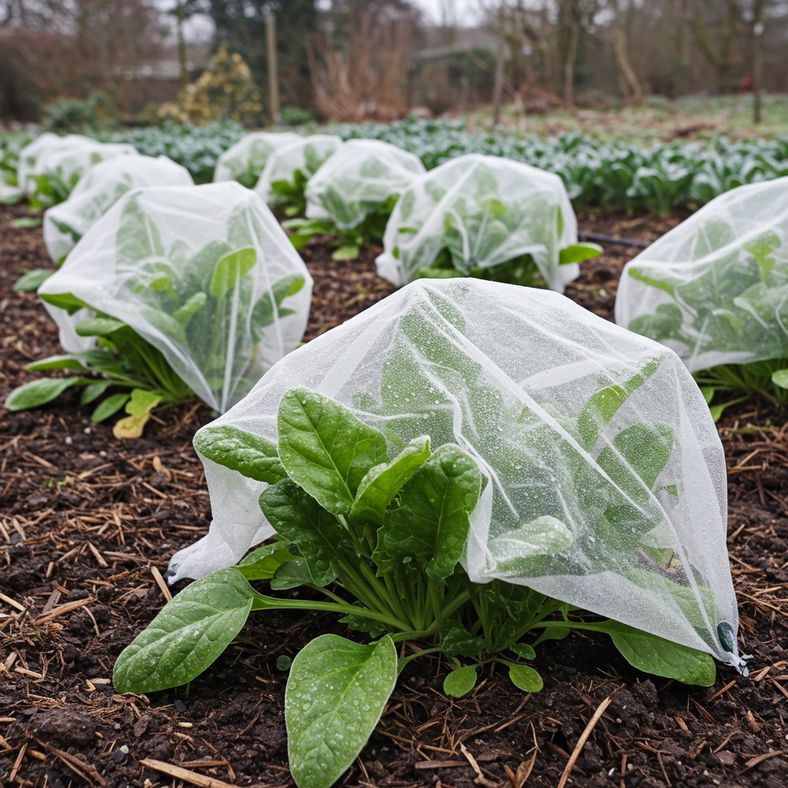
One of perpetual spinach's greatest advantages is its exceptional winter hardiness. July-planted crops will survive UK winters with minimal protection, continuing to provide fresh leaves throughout the coldest months.
Winter Hardiness
Perpetual spinach demonstrates remarkable cold tolerance:
- Frost resistance: Survives temperatures down to -10°C
- Snow tolerance: Leaves may be damaged but plants survive under snow
- Wind resistance: Better cold tolerance than annual spinach varieties
- Recovery ability: Quickly produces new growth when conditions improve
Protection Methods
Minimal protection needed: Unlike many vegetables, perpetual spinach requires little winter protection:
- Natural shelter: Plant near walls or hedges for wind protection
- Mulching: Apply 5-7cm of organic mulch around plants in November
- Fleece covering: Use only during severe weather (below -5°C)
- Cloches: Individual plant protection for exposed sites
Winter Maintenance
Reduced watering: Natural rainfall usually provides sufficient moisture. Only water during extended dry periods.
Minimal feeding: Avoid fertilising between November and February to prevent soft growth susceptible to frost damage.
Gentle harvesting: Pick only what's needed during coldest months. Plants recover more slowly in winter.
Pest monitoring: Watch for aphids in mild spells and remove affected leaves promptly.
Container Growing in Winter
If growing in containers:
- Insulation: Wrap pots with bubble wrap or hessian
- Drainage: Ensure containers don't become waterlogged
- Positioning: Move to sheltered spots during severe weather
- Watering: Check soil moisture as containers dry out faster
Extended Season Benefits
July-planted perpetual spinach offers unique winter advantages:
- Fresh vegetables: Homegrown greens when shops offer expensive imports
- Nutritional value: Higher vitamin content than stored vegetables
- Garden activity: Provides purpose for winter garden visits
- Cost savings: Reduces grocery bills during expensive winter months
Spring Renewal
As temperatures rise in March-April:
- Remove protection: Take away fleece and cloches
- Clear debris: Remove damaged leaves and winter mulch
- Resume feeding: Apply liquid fertiliser to encourage new growth
- Increase harvesting: Plants enter renewed growth phase
For winter protection and extended growing, consider investing in JiveSnip Premium Titanium Garden Secateurs, perfect for precise harvesting throughout the winter months.
Common Problems and Solutions
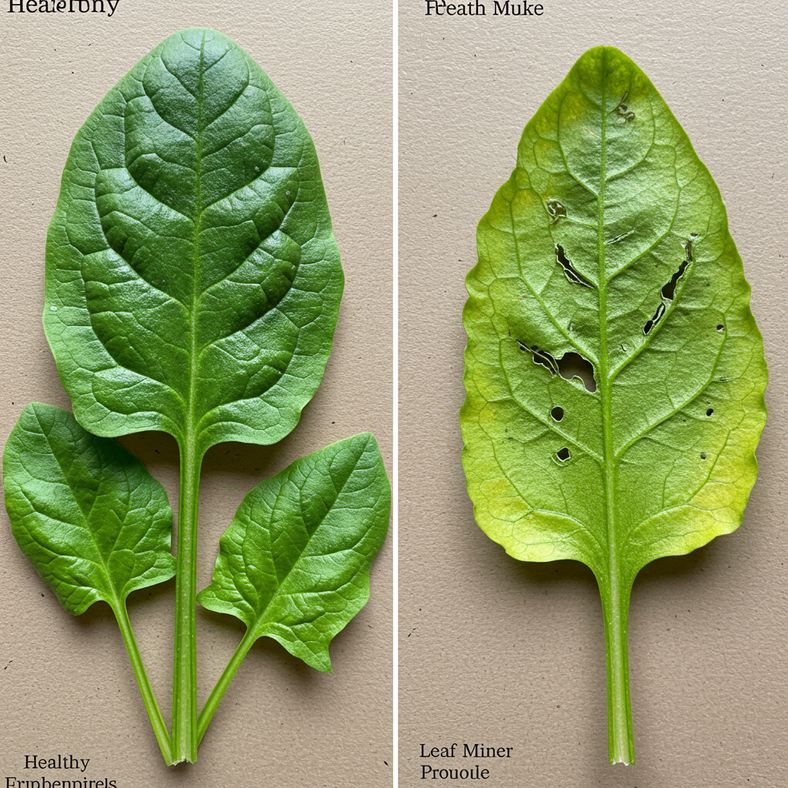
While perpetual spinach is remarkably trouble-free, understanding potential issues and their solutions ensures consistently successful crops from your July plantings.
Germination Problems
Poor germination rates:
- Cause: Soil too hot (above 25°C), old seeds, or inconsistent moisture
- Solution: Sow in partial shade during hot spells, use fresh seeds, maintain consistent moisture
- Prevention: Test soil temperature, buy seeds from reputable suppliers, water regularly
Uneven germination:
- Cause: Uneven soil moisture or depth variation
- Solution: Level soil surface, ensure consistent drill depth, use soaker hoses
- Prevention: Prepare soil thoroughly, mark drill depth, check moisture levels daily
Growth Issues
Slow growth:
- Cause: Poor soil nutrition, overwatering, or insufficient light
- Solution: Apply balanced fertiliser, improve drainage, relocate containers
- Prevention: Prepare soil with compost, ensure good drainage, choose sunny locations
Yellowing leaves:
- Cause: Nutrient deficiency, overwatering, or natural aging
- Solution: Apply nitrogen-rich fertiliser, reduce watering, remove old leaves
- Prevention: Regular feeding, proper watering schedule, routine maintenance
Pest Management
Aphids:
- Identification: Small green or black insects on leaf undersides
- Control: Rinse off with water, encourage beneficial insects, remove affected leaves
- Prevention: Avoid over-fertilising, maintain good air circulation
Leaf miners:
- Identification: White tunnels visible in leaves
- Control: Remove affected leaves immediately, dispose in household waste
- Prevention: Use fine mesh covers, encourage beneficial insects
Slugs and snails:
- Identification: Irregular holes in leaves, slime trails
- Control: Hand-picking, beer traps, organic slug pellets
- Prevention: Clear debris, reduce mulch thickness, use copper barriers
Disease Prevention
Downy mildew:
- Symptoms: Yellow patches on upper leaves, white growth underneath
- Prevention: Ensure good air circulation, avoid overhead watering, thin plants adequately
- Treatment: Remove affected leaves, improve ventilation, reduce humidity
Damping off:
- Symptoms: Seedlings collapse at soil level
- Prevention: Use sterile compost, avoid overwatering, ensure good drainage
- Treatment: Remove affected seedlings, improve conditions, re-sow if necessary
Environmental Stress
Bitter leaves:
- Cause: Water stress, excessive heat, or over-mature leaves
- Solution: Increase watering, provide shade, harvest more frequently
- Prevention: Consistent moisture, summer shading, regular picking
Bolting (rare in perpetual spinach):
- Cause: Extreme stress, very hot weather, or second-year plants
- Solution: Remove flower stems, increase watering, provide shade
- Prevention: Consistent care, adequate moisture, replacement planting
Troubleshooting Tips
- Monitor regularly: Check plants weekly for early problem detection
- Maintain garden hygiene: Remove debris and diseased material promptly
- Encourage beneficial insects: Plant flowers nearby to attract predators
- Keep records: Note problems and solutions for future reference
Companion Planting and Garden Integration
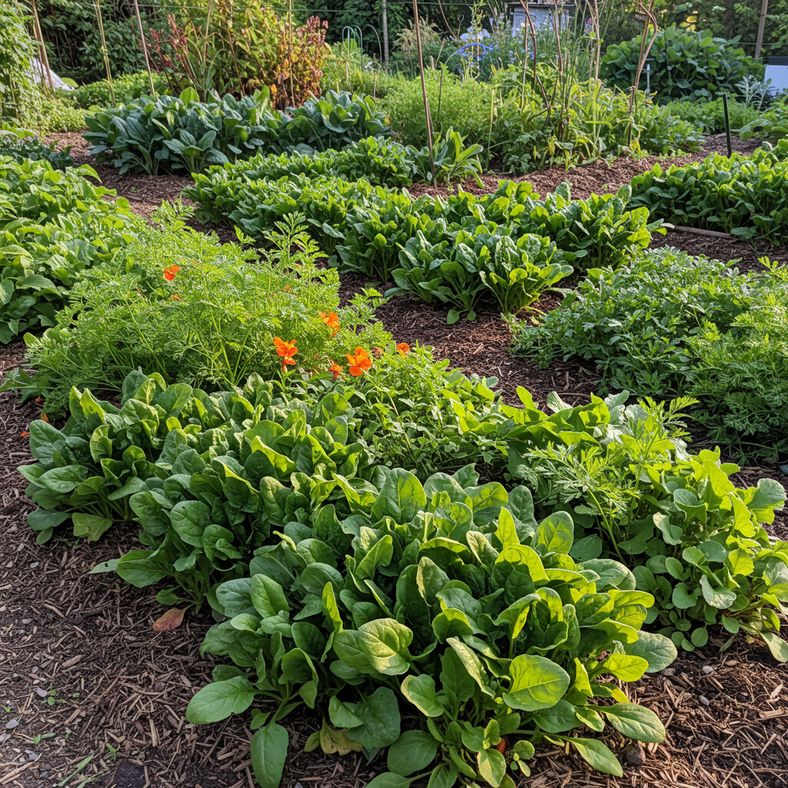
Perpetual spinach integrates beautifully into diverse garden settings, offering excellent companion planting opportunities that enhance both productivity and pest management in your July plantings.
Beneficial Companions
Vegetables that thrive alongside perpetual spinach:
- Carrots: Deep roots complement spinach's shallow system, efficient space use
- Radishes: Quick-growing, break up soil, harvested before spinach matures
- Lettuce: Similar growing requirements, succession planting opportunities
- Onions and garlic: Repel pests, don't compete for nutrients
- Peas and beans: Fix nitrogen, provide vertical interest
Herbs that enhance growth:
- Parsley: Attracts beneficial insects, similar care requirements
- Chives: Pest deterrent, perennial structure
- Dill: Attracts predatory insects, harvest before flowering
- Oregano: Natural pest repellent, aromatic garden layer
Companion Planting Strategies
Interplanting for July sowing:
- Quick crops: Sow radishes and lettuce between spinach rows for efficient space use
- Succession planting: Replace harvested crops with new spinach sowings
- Vertical layering: Use climbing beans or peas to provide summer shade
- Edge planting: Create borders with herbs around spinach beds
Timing considerations:
- July planting: Coordinate with autumn brassicas and winter salads
- Space planning: Account for spinach's 10-month growing period
- Harvest coordination: Plan complementary crops with different harvest times
Plants to Avoid
Incompatible companions:
- Brassicas: Compete for similar nutrients, susceptible to same pests
- Fennel: Allelopathic effects inhibit growth of nearby plants
- Large vegetables: Sweetcorn, courgettes create excessive shade
- Deep-rooted perennials: Compete for water and nutrients
Garden Design Integration
Ornamental combinations:
- Flower borders: Dark green foliage contrasts beautifully with colorful annuals
- Edible landscaping: Create attractive, productive garden features
- Container gardens: Combine with trailing herbs and compact vegetables
- Wildlife gardens: Provide cover and food for beneficial insects
Seasonal interest:
- Summer structure: Provides consistent green backdrop
- Autumn color: Maintains interest when other crops fade
- Winter presence: Offers year-round garden activity
- Spring renewal: Fresh growth signals seasonal change
Crop Rotation Considerations
Rotation planning:
- Beet family: Rotate with legumes and brassicas
- Soil improvement: Follow with nitrogen-fixing crops
- Pest management: Break disease cycles through rotation
- Nutrient management: Vary feeding requirements across seasons
For successful companion planting, consider starting with Garden Dwarf French Bean Opera Seeds as an excellent nitrogen-fixing companion crop.
Nutritional Benefits and Culinary Uses
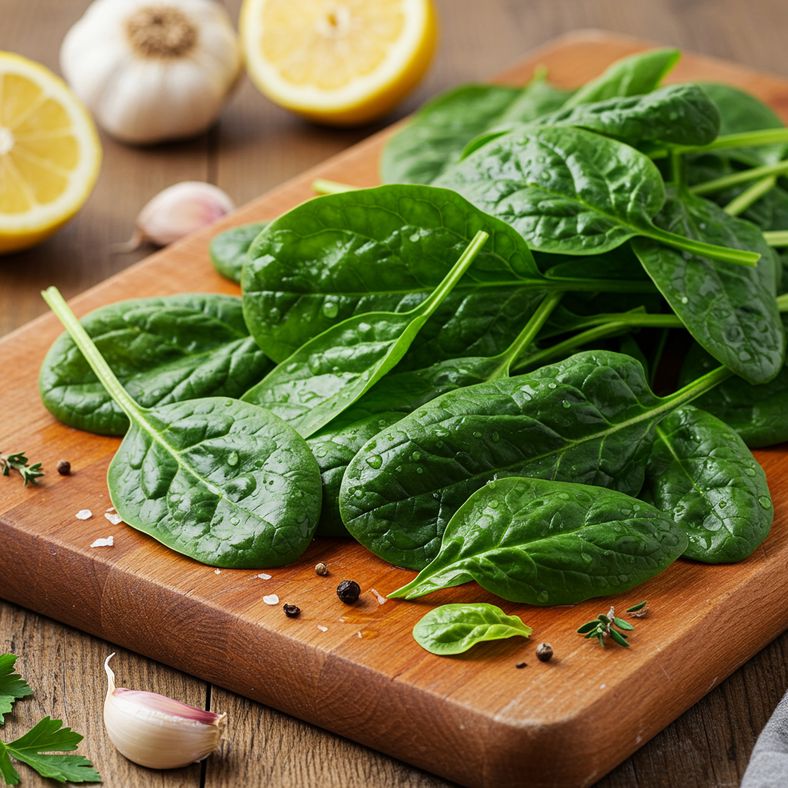
Perpetual spinach offers exceptional nutritional value and culinary versatility, making your July plantings a valuable addition to healthy eating throughout the year.
Nutritional Profile
Vitamin content:
- Vitamin A: Essential for eye health and immune function
- Vitamin C: Antioxidant properties, supports immune system
- Vitamin K: Important for bone health and blood clotting
- Folate: Crucial for cell division and DNA synthesis
- B vitamins: Support energy metabolism and nervous system
Mineral content:
- Iron: Higher bioavailability than many plant sources
- Calcium: Important for bone and teeth health
- Magnesium: Essential for muscle and nerve function
- Potassium: Supports heart health and blood pressure regulation
- Manganese: Antioxidant properties and bone development
Additional benefits:
- Low calories: Excellent for weight management
- High fiber: Supports digestive health
- Antioxidants: Lutein and zeaxanthin for eye health
- Nitrates: May support cardiovascular health
Culinary Applications
Raw preparations:
- Baby leaves: Perfect for salads, sandwiches, and wraps
- Smoothies: Mild flavor blends well with fruits
- Garnishes: Attractive addition to soups and main dishes
- Microgreens: Harvest very young for intense flavor
Cooked preparations:
- Sautéed: Quick cooking preserves nutrients and texture
- Steamed: Gentle method that maintains color and vitamins
- Soup ingredient: Adds nutrition and color to broths
- Pasta dishes: Wilts beautifully into hot pasta
- Quiches and frittatas: Excellent egg dish ingredient
Seasonal Cooking Ideas
Autumn harvests (September-November):
- Warm salads: Combine with roasted vegetables
- Stir-fries: Add at the end for fresh color
- Soups: Hearty autumn broths with root vegetables
Winter use (December-February):
- Comfort foods: Add to casseroles and stews
- Pasta bakes: Incorporate into baked dishes
- Green smoothies: Boost winter nutrition
Spring renewal (March-May):
- Fresh salads: Celebrate renewed growth
- Light soups: Welcome spring with fresh flavors
- Sandwich fillings: Fresh leaves for lunch boxes
Storage and Preparation
Optimal storage:
- Fresh use: Best consumed within 2-3 days of harvest
- Refrigeration: Store in perforated bags in vegetable drawer
- Washing: Rinse just before use to maintain quality
- Freezing: Blanch for 2 minutes before freezing
Preparation tips:
- Washing: Soak in cold water to remove soil particles
- Stem removal: Trim tough stems from larger leaves
- Cooking time: Slightly longer than regular spinach
- Seasoning: Pairs well with garlic, lemon, and nutmeg
Health Considerations
Oxalate content: Moderate levels compared to regular spinach, generally safe for most people
Digestibility: Easier to digest than some leafy greens
Allergen information: Generally well-tolerated, rare allergic reactions
Medication interactions: High vitamin K content may affect blood thinning medications